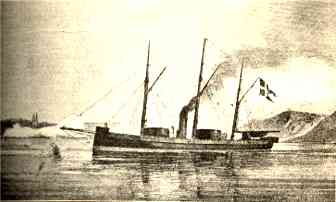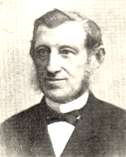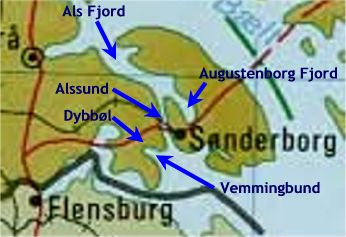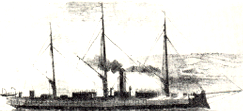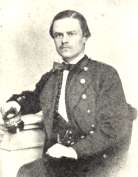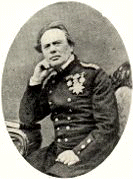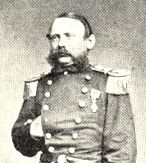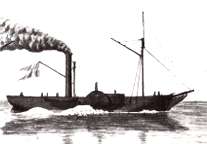|
You are here: 4Campaigns & Battles4Index4The Battle for Als |
|||||||||||||||||||||||||||||||||||||||||||||||||||||||||||
|
The Battle for Als (1864):
The ironclad monitor
ROLF KRAKE in Vemmingbund, 1864.
306 60-pound Shells
|
||||||||||||||||||||||||||||||||||||||||||||||||||||||||||
|
Off to War immediately On February 18, just one week after leaving Copenhagen, the ironclad fired its four sixty-pounders in harms way for the first time. ROLF KRAKE's assignment was to destroy a bridge, which the Prussians had built over the mouth of the Nybøl Cove. The ship sailed into Flensborg fjord, and off Egernsund initiated a strong indirect shelling of the bridge. The shallow waters made it impossible for ROLF KRAKE to get close enough to take a direct shot at the bridge. After 1½ hours, the firing of 57 shots and being under heavy enemy fire, the commander made the decision to return to Sønderborg. ROLF KRAKE had been hit around one-houndred times and had three wounded men on-board. |
Commander |
However, even though firing from only 1,400 to 2,000 meters, the Prussian artillery had failed to penetrate the ships armor.
Prussian Dismay
After ROLF KRAKE's return to Sønderborg, a commission from the Naval Dock Yard in Copenhagen assessed its damages. Their first impression was that the ship should return to Copenhagen for repairs.
The Supreme Command was, however, of the opinion the ship could not be spared, and the damages were therefore repaired with local assistance while lying at anchor in Sønderborg.
The Prussians were somewhat dismayed at the effect of the ironclad monitor's efforts. They had never before been on the receiving end of the guns of an ironclad monitor's ironclad's cannon.
Unfortunately, since cooperation between the Navy and the Army had not been developed enough to take advantage of ROLF KRAKE's guns, the coordinated effort did not have the effect that it might have. To this end, the communication possibilities between ship and shore were inadequate.
Continued Reconnaissance
|
On February 22 and 26, ROLF KRAKE was once again on a reconnaissance mission in Vemmingbund to observe on the Prussian progress in establishing artillery positions. Even though the ship was a mere 500 meters from land, it was not possible to observe either troop movement or other military activity. Neither was the ship exposed to any type of enemy fire. Dybbøl stormed |
The area around Als. |
At 3:00 am on March 28, 1864, the Prussian troops stormed the Dybbøl defenses for the first time.
At the break of day the broadside ironclad, ROLF KRAKE, weighed anchor and sailed from Sønderborg to the northern part of Vemmingbund. Immediately it was attacked from the elevated Prussian artillery batteries at Broager.
The ship took several direct hits, but chose not to return fire. It continued to the gorge by the Danish front redoubts in the Dybbøl position, redoubts II and I. Here it opened an exceedingly effective flanking fire against the advancing Prussian troops.
|
ROLF KRAKE's fire along with the fierce resistance of the Danish troops quickly created disorder in the Prussian ranks and the attack ground to a sudden halt. The main Prussian force chose to retire from the field while a smaller force, one officer and 26 men, unable to retreat through ROLF KRAKE's barrage, was captured by the Danish forces. |
ROLF KRAKE in Vemmingbund |
The Prussian storm had been averted, and after having fires 38 shells, the ironclad monitor returned to Sønderborg.
ROLF KRAKE had suffered no losses of personnel, but had once again sustained some material damage. The supreme command declared that ROLF KRAKE's barrage had had an excellent effect.
Fishnet versus Ironclad
Once again, the Prussians had seen which effect an ironclad monitor could have!
They now decided to use untraditional methods to put an end to ROLF KRAKE's interference. The following nights, they lay a large number of fishnets in the waters of Vemmingbund.
The intent was to get the nets tangled in the ship's propeller or deter ROLF KRAKE from entering Vemmingbund for fear of being entangled in the nets.
The nets, however, were quickly spotted from ROLF KRAKE. On the morning of April 10, in a thick fog, a smaller vessel was sent in to Vemmingbund to either sink or collect the nets.
The vessel's commander, sub lieutenant W. B. Jespersen, was quickly able to neutralize a number of the nets, but came under enemy fire and was forced to withdraw when the fog lifted.
The Calm before the Storm
Around the middle of April, the Danish forces observed increased enemy activity, in spite of the diplomatic efforts to stop the war.
Denmark and Prussia/Austria had in fact been summoned to a conference in London on April 20, 1864 to establish a truce.
The Danes were, however, not in the least in doubt that the Prussians would attempt to capture Dybbøl before the beginning of the conference.
Therefore, the Danish forces remained on full alert.
The Second Storming of Dybbøl
At 4 am, on the morning of April 18, 1864, the Prussians began a violent bombardment of the Danish lines of defense to weaken the ability to resist.
|
At precisely 10 am, the shelling stopped and the Prussian attack on the Danish forces began. From the ironclad monitor ROLF KRAKE it was evident what was happening, and Commander Rothe chose to sail immediately in to Vemmingbund to support the Danish forces, even though he had not received the agreed upon signal. The ironclad opened fire at once upon the advancing enemy columns, and was itself subject to heavy enemy fire. An enemy grenade penetrated ROLF KRAKE's top deck and exploded on the orlop deck killing Sub Lieutenant W. B. Jespersen and wounding nine others. Almost simultaneously, a piece of shrapnel penetrated the grating of the front gun and seriously wounded one of the artillery crew. |
Sub
Lieutenant |
In spite of taking many hits, ROLF KRAKE was successful in creating disorder in the Prussian ranks, firing 95 volleys against the Prussian right flank. At one point in the struggle, the ship's volleys helped drive the Prussians back.
In the long run, however, the ROLF KRAKE was not able to play a deciding role in the struggle on land. When the Danish troops were forced back towards Sønderborg, the commander chose to withdraw beyond the range of the enemy's guns.
Later in the afternoon, the ship again dropped anchor off Sønderborg.
Temporary ceasefire
After the fall of Dybbøl, the army concentrated on the defense of Sønderborg and Als.
Therefore, ROLF KRAKE was on April 19, ordered to Augustenborg bay, out of the reach of the Prussian artillery on the Jutland side. ROLF KRAKE stayed here until a temporary ceasefire between Prussia/Austria and Denmark was established on May 12.
|
The same day the ceasefire became a reality, the ship sailed for the naval wharf in Copenhagen for necessary repairs after the damaged sustained in the first battles. The ROLF KRAKE was already back in place in the Baltic squadron on June 12, this time under the command of Captain C. van Dockum. The Baltic squadron consisted of 15 of Denmark's largest armed ships, with the screw propelled frigate SJÆLLAND as flagship. During the next two weeks, the squadron patrolled the waters between Langelands southern tip and the Kiel Bay. The Prussians could see the smoke from the large fleet on a daily basis. On the night between June 25 and 26, the ships were ordered to battle stations prior to the end of the ceasefire. |
Captain
C. van Dockum, |
The defense of Als
ROLF KRAKE had orders to sail to a position north of Als, where Commander Rothe was ordered to assume his previous station in Augustenborg bay. His assignment was to work with the army in preventing the enemy crossing Als bay and the northern part of Alssund.
The Prussian forces had taken advantage of the cease-fire to position several batteries of cannon with rifled barrels along the Jutland shore making it near impossible for the Danish ships to navigate the waters of the bay in daylight.
To ensure that ROLF KRAKE would be able to aid the army in time, it was agreed to light signal fires on land if the enemy attempted a crossing of Als Sound.
The ironclad monitor remained at anchor in Augustenborg Bay on full battle alert – which meant a full head of steam in the boilers and manned battle stations. Further, the ship sent patrol boats along the north shore of Als Sound to keep an eye on the Prussian force's movements towards the Sound.
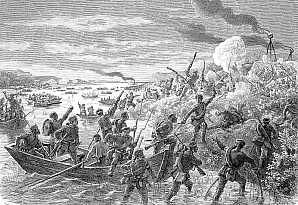
The Prussian forces cross Als Sound.
(Contemporary copper engraving)
Prussian forces cross Als Sound
At 2 AM on 29 June 29, the men aboard ROLF KRAKE could hear a tremendous amount of rifle fire from Als Sound. It was assumed that the Prussians had begun their move to cross the sound.
Commander Rothe sounded the alarm and ordered the ship to sail immediately to a position north of Als Sound.
|
When the ironclad monitor arrived at 3 AM, the sound was filled with boats moving back and forth across the sound. OLF KRAKE opened fire at once against the boats, first with grapeshot and later, grenades and the heavy fire from the ironclad rained death and destruction on the small boats crossing the sound. A large number of the boats were dispersed and forced to seek the nearest coast bringing the crossing to an immediate stop. The course of the battle was less evident on board the ROLF KRAKE. The command had no clear picture of the military situation. Neither did it know how many Prussians troops had succeeded in crossing the sound. |
Lieutenant Commander |
Aware that the ship would be subjected to heavy fire with the light of dawn and unaware of how much good could be done by staying in place, the commander, after consulting with his second-in-command, Lieutenant Commander E. Duntzfelt, made the decision to return to Augustenborg Bay. Here he could contact the army and receive reliable intelligence on the situation.
Retreat according to plan
After keeping the ship in action in Augustenborg Bay without the necessary information, and after being under heavy enemy fire, Commander Rothe, according to his operational orders, sailed around Als to assist in evacuating troops should it be required.
At approximately 5 AM ROLF KRAKE sailed north up Als Sound under heavy enemy fire from the batteries on the Jutland side.
There was a small Danish force stationed in the sound consisting of the paddle wheeler HERTHA, under the command of Lieutenant H. E. Bluhme, and the screw propellered gunboat WILLEMOES, under the command of Lieutenant A. C. R. Bærentzen. In addition, three cannon barges and one cannon yawl.
|
Commander Rothe decided to take these ships north as well to bring them out of the enemy’s range of fire. The ships were tied to the starboard side of the ROLF KRAKE, and were thus protected form the Prussian fire. First the HERTHA and a cannon barge, thereafter the WILLEMOES and another cannon barge were brought out. The escort was performed under heavy Prussian fire, which the ROLF KRAKE returned. |
The Paddle Wheeler HERTHA. |
Cannon barge number 19, under the command of Lieutenant of the Reserve H. P. Marcher and cannon yawl BAAGØ, under the command of Lieutenant of the Reserve P. C. Petersen had to be left, therefore, the vessels were destroyed and the crew taken on board the other ships.
The loss of Als
After having evacuated the Danish ships, the ROLF KRAKE continued around Als to assist in the evacuation of troops to the island of Fyn.
The ironclad monitor had succeeded in firing a total of 116 shots on June 29, 1864, but the loss of Als was now a fact.
The ironclad had been hit numerous times but its armor was never pierced. However, the mizzenmast had been so heavily damaged that it was necessary to cut it off.
In total, the ROLF KRAKE from March to June 1864 had fired 306 60-pound grenades in the battle for Als. Those grenades alone were not enough to stop the Prussian invasion.
Epilogue
Until the ceasefire between Denmark and Prussia/Austria on July 20 was effectuated, the ROLF KRAKE together with the other ships, including the armored schooner ESBERN SNARE, continued to patrol the waters between Als and Fyn to prohibit and enemy advances towards that island.
On seven august 1864, the ironclad montior ROLF KRAKE returned to Copenhagen.
The loss of Als, however, had caused grief and anger in the entire nation. It was necessary to find a scapegoat. The rage and disappointment were directed at the army, but also at the role played by ROLF KRAKE.
A special commission was formed in 1865, after among others, Commander Rothe's wishes. It examined the circumstances and actions connected with the defense of Als. In December 1866, it dismissed all charges brought against Rothe. He had done what it had been possible for him to do.
|
Sources: |
||
|
& |
Den Danske Flaades Skibe i Sidste Aarhundrede, by etatsråd H. Degenkolv, Lehmann & Stages Boghandel, Copenhagen, 1906 |
|
|
& |
Den Danske og Norske Sømagt, by I. C. Tuxen, P. G. Philipsens Forlag, Copenhagen, 1875 |
|
|
& |
Officerer i den Dansk-Norske Søetat 1660-1814 og den Danske Søetat 1814-1932, Bind I og II, by Th. A. Topsøe-Jensen and Emil Marquard, H. Hagerups Forlag, Copenhagen, 1935. |
|
|
& |
Vor sidste kamp for Sønderjylland, by Axel Liljefalk and |
|
|
& |
Vore Panserskibe 1863-1943, by R. Steen Steensen, Marinehistorisk Selskab, Copenhagen 1968 |
|
|
44You are also referred to the Naval Bibliography |
||
![]()
- Do you miss a major event on this Site,
or do you hold a great story?
Are you able to contribute to the unfolding of
the Danish Naval History,
please
e-mail
me, enclosures are welcome.
Please remember to list your sources.
You can also use the Naval Web Forum on this web-site.
![]()
|
MORE IN-DEPTH STORIES FROM |
|
The Battle for Als (1864) - The Battle off Heligoland (1864) |
|
THE TOPIC STORIES: |
|
- Wars against England (1801-1814) - Reconstructing the Navy (1814-1848) - The 1st Schleswig War (1848-50) - The interim War Years (1850-64) - The 2nd Schleswig War (1864) - The long Period of Peace (1864-1914) - The Navy during the 1st World War (1914-1918) - The Interim Years (1919-1939) - The Navy during the 2nd World War (1939-1945) - The Cold War Period (1945-1989) - |
|
SEE ALSO: |
|
- |
-
This page was last updated: -
This page was first published: November 12, 2006
Copyright © 2013-2016 Johnny E. Balsved - All rights reserved - Privacy Policy

